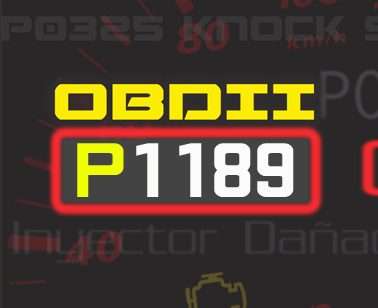
P1189 (Volkswagen, Audi, Skoda, Seat) Linear lambda probe, compensation resistor - short circuit to positive
Content
P1189 – OBD-II Trouble Code Technical Description
Trouble code P1189 indicates a problem with the linear oxygen sensor, namely a short circuit to positive in the compensating resistor circuit in Volkswagen, Audi, Skoda, Seat cars.
What does the fault code mean P1189?
Trouble code P1189 indicates a problem with the vehicle's linear oxygen sensor, specifically a short to positive in the compensation resistor circuit. The linear oxygen sensor is an important component of the engine management system that monitors the oxygen content of the exhaust gases. The compensation resistor is designed to stabilize the voltage and ensure correct operation of the sensor. A short circuit to positive in the compensation resistor circuit can lead to incorrect operation of the oxygen sensor. This can cause an erroneous reading of the oxygen content in the exhaust gases, which in turn can lead to incorrect fuel mixture adjustments and other engine performance problems.

Possible reasons
Some possible causes of the P1189 trouble code:
- Damaged compensation resistor: The compensation resistor itself may be damaged or open, resulting in a short circuit to positive.
- Short circuit in wiring: The wiring connecting the compensation resistor to the engine control system may be damaged or broken, causing a short circuit.
- Damaged connectors: The connectors connecting the compensation resistor to the wiring or engine control system may be damaged or have oxidized contacts, which may cause a short circuit.
- Faulty linear oxygen sensor: Although the problem points to the compensating resistor, the linear oxygen sensor itself may also be faulty, which could result in a short to positive in its circuit.
- Problems with the engine management system: Improper operation of the engine management system, such as due to software errors or electronic failures, can also cause trouble code P1189 to appear.
To accurately determine the cause, detailed diagnostics of the wiring, engine management system components and linear oxygen sensor are required.
What are the symptoms of a fault code? P1189?
Symptoms for a P1189 trouble code can be varied and may vary depending on the specific vehicle and the extent of the problem, but some of the possible symptoms that may occur are:
- Increased fuel consumption: A short to positive in the compensating resistor circuit may cause the linear oxygen sensor to malfunction, which may result in incorrect fuel mixture adjustment. This, in turn, can lead to increased fuel consumption.
- Unstable engine performance: Improper fuel mixture adjustment can cause the engine to run rough, especially at low speeds or when the idle control system is activated.
- Increased emissions of harmful substances: If the fuel mixture is not adjusted correctly due to a faulty compensation resistor, it may result in increased exhaust emissions.
- Power drop: Improper fuel mixture adjustment may result in a decrease in engine power, especially when the emission control system is activated or when accelerating.
- Intermittent idling: If the compensating resistor or linear oxygen sensor is not working properly, the engine may experience rough idling or even stop unexpectedly.
It is important to note that symptoms may appear differently under different operating conditions and may be accompanied by errors or warnings on the instrument panel. If you notice any of these symptoms, it is recommended that you get the problem diagnosed and corrected as soon as possible.
How to diagnose a fault code P1189?
The following approach is recommended to diagnose DTC P1189:
- Using a scanner to read error codes: First, connect the scanner to your vehicle's diagnostic port and read the error codes. Make sure the code P1189 is actually listed.
- Checking wiring and connectors: Check the wiring connecting the compensation resistor to the engine control system for damage, breaks or corrosion. Also check the condition of the connectors for oxidation or broken contacts.
- Checking the compensation resistor: Check the resistance of the compensation resistor using a multimeter. The normal resistance should be according to your car's specifications. If the resistance is very different from normal, the compensating resistor may be faulty and needs to be replaced.
- Checking the linear oxygen sensor: Check the condition of the linear oxygen sensor. Make sure it is not damaged and connected correctly. If there is a suspicion that the linear oxygen sensor is faulty, it may need to be replaced.
- Additional tests: In some cases, additional tests may be required, such as checking the voltage on the compensation resistor circuit and diagnosing the engine management system to identify other problems.
If you are unsure of your diagnostic skills or do not have the necessary equipment, it is best to contact a qualified auto mechanic or service center to professionally diagnose and fix the problem.
Diagnostic errors
When diagnosing DTC P1189, the following errors may occur:
- Ignoring other system components: The error can occur if one focuses only on the compensating resistor without considering other possible causes such as problems with the wiring, connectors or the linear oxygen sensor itself.
- Misinterpretation of data: Incorrect interpretation of data from a multimeter or scanner may lead to an incorrect diagnosis of the problem. For example, misreading the value of a compensation resistor can lead to erroneous conclusions about its condition.
- Unaccounted external factors: Some external factors such as corrosion, moisture or mechanical damage may be the cause of the problem, but are not always easy to detect. Their incorrect assessment can lead to incorrect diagnosis.
- Failure to perform comprehensive diagnostics: Sometimes diagnostics are limited to only checking one component, ignoring possible problems with other parts of the system. This may lead to incomplete or incorrect diagnosis.
- Incorrect component replacement: If a component is incorrectly identified as faulty and is replaced without proper diagnosis, this may result in additional repair costs without correcting the underlying problem.
To avoid these errors, it is important to conduct a thorough diagnosis, including checking all associated components and correctly interpreting the data obtained.
How serious is the fault code? P1189?
Trouble code P1189 indicates a problem with the linear oxygen sensor and its associated components. Depending on the specific nature of the problem and the degree of its impact on engine operation, this code can have varying degrees of severity. If the problem remains undiagnosed and unresolved, it can lead to the following consequences:
- Increased fuel consumption: Insufficient adjustment of the fuel/air mixture may result in increased fuel consumption.
- Increased emissions of harmful substances: Incorrect fuel/air ratios may result in increased emissions, which may attract the attention of the relevant regulatory authorities and, in some cases, result in a failing technical inspection (MOT).
- Loss of power and unstable engine operation: An improper fuel/air mixture can affect engine performance, causing loss of power, rough running, or even starting problems.
- Damage to the catalytic converter: If the catalytic converter is operated for an extended period of time with an incorrect fuel/air mixture, it may become damaged and require replacement.
So while the P1189 code is not a safety critical code in itself, it does indicate problems with engine performance and fuel efficiency. It is important to diagnose and fix this problem as soon as possible to prevent possible negative consequences for the vehicle and the environment.
What repair will help eliminate the code? P1189?
Resolving trouble code P1189 requires a systematic approach to diagnosis and repair, including the following steps:
- Checking wiring and connectors: The first step is to check the wiring and connectors connecting the linear oxygen sensor to the engine management system. It is necessary to ensure their integrity and the absence of corrosion or oxidation.
- Checking the compensation resistor: Check the compensating resistor for a short circuit to positive or ground. If any faults are found, it is recommended to replace the compensation resistor.
- Checking the linear oxygen sensor: Check the condition of the linear oxygen sensor for damage or corrosion. If the sensor is damaged or its operation is suspicious, it should be replaced.
- Additional diagnostics of the engine management system: In some cases, the cause of the P1189 code may be related to other engine management system components, such as the mass air flow or throttle body sensors. Perform additional tests to rule out or detect problems with these components.
- Clearing errors and re-diagnosis: After performing repairs and replacing components, clear the errors using a scanner and re-read the error codes to ensure that the problem has been successfully resolved.
If you do not have the experience or necessary equipment to perform diagnostics and repairs, it is recommended that you contact a qualified auto mechanic or service center for professional assistance.

